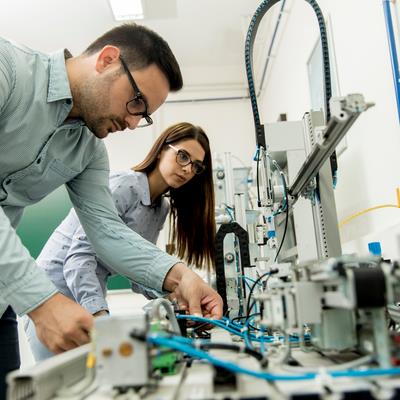prof. shravan h. gawande
Modern Education Society's College of Engineering Pune India
Pune, India
1,895
Total downloads
13k
Total views and downloads
Submission closed
Mechanical engineering is all about designing and developing machines that solve complex problems faced by society. Therefore, design plays a crucial role in Mechanical Engineering, as it is the foundation on which every machine is built. In addition, it is the process of turning abstract concepts and ideas into reality. Vibration may influence the durability and reliability of machinery systems or structures and cause problems such as damage, abnormal stopping, and catastrophic failures. Vibration measurement is an important countermeasure to prevent these problems from occurring.
Mechanical design plays a crucial role in managing vibrations in various engineering applications. Here are some key points regarding its significance:
Structural Integrity
• Proper mechanical design ensures that structures can withstand dynamic forces and vibrations without failure. This is vital in applications like bridges, buildings, and machinery;
Performance Optimization
• Effective design can enhance the performance of mechanical systems by minimizing unwanted vibrations that may lead to inefficiencies, noise, and wear over time;
Safety
• Ensuring that components can handle vibrational loads is essential for safety. In industries like aerospace and automotive, failure to address vibration can lead to catastrophic consequences;
Comfort and Ergonomics
• In consumer products and vehicles, mechanical design aims to reduce vibrations that affect user comfort, enhancing the overall experience;
Longevity of Equipment
• By designing for vibration control, engineers can extend the lifespan of machinery and equipment, reducing maintenance costs and downtime;
Precision Engineering
• In applications requiring high precision, such as robotics and CNC machines, minimizing vibrations is critical to maintain accuracy in operations;
Vibration Isolation
• Mechanical design incorporates methods like isolators and dampers to minimize the transmission of vibrations, protecting sensitive equipment from external disturbances;
Dynamic Analysis
• Advanced mechanical design involves dynamic analysis to predict how systems respond to vibrational forces, allowing for informed design choices and modifications;
Material Selection
• The choice of materials can significantly impact a design’s vibrational characteristics. Engineers select materials that optimize strength, weight, and damping properties;
Compliance with Standards
• Many industries have strict regulations regarding vibration levels. Effective mechanical design ensures compliance with these standards, which is essential for certification and operational approval.
In summary, the significance of mechanical design in vibration lies in its ability to enhance safety, performance, and durability while also ensuring comfort and compliance with industry standards.
The aim of Recent Advances in Mechanical Design and Vibration is to act as a platform for the dissemination of innovative and original research and development work in the area of mechanical design, and vibration. This special issue collection communicates original contributions of permanent interest in all aspects of the design and vibrations of mechanical systems. This special issue collaboration publishes technical articles in design and vibration related to innovative work and discussions. Articles may be theoretical, numerical or experimental in nature. But those which combine theoretical, numerical and experimental approaches to solve design, and vibration problems are particularly welcome.
Subject areas include, but are not limited to the following fields:
• Design automation, including design representation, geometric design, Design theory and methodology, including creativity in design, decision analysis, design cognition, design synthesis and design evaluation;
• Design for manufacturing and the life cycle, including design for the environment.
• Design innovation and devices, including design of smart products and materials;
• Design of direct contact systems, including cams, gears and power transmission systems;
• Design of energy, fluid, and power handling systems;
• Design of mechanisms and robotic systems, including design of macro-, micro- and nano-scaled mechanical systems, machine components, and machine system design;
• Design optimization, risk and reliability-based optimization, design sensitivity analysis, and system design integration;
• Bio-inspired design (BID);
• Electromechanical noise and vibration;
• Ergonomic and aesthetic considerations;
• Flow-induced noise and vibration;
• Front-end accessory drive noise and vibration;
• Human perception and sound quality;
• Linear and non-linear vibrations, Random vibration;
• Machinery dynamics;
• Modal analysis;
• Passive and active vibrations;
• Power-train and components noise and vibration;
• Rotor dynamics and vibration;
• Vehicle and machinery vibration, noise measurement and noise control;
• Vibration of continuous and lumped parameter systems;
• Active vibration control;
• Vibration Isolation;
• Vibration Suppression;
• Vibration Absorption;
• Vibration-based energy harvesting;
• Bio-inspired vibration control;
• Multi-stable systems;
• Quasi-zero-stiffness (QZS) systems.

Keywords: Design, Design optimization, Structural Health Monitoring, Active Vibration Control, Noise & Vibration
Important note: All contributions to this Research Topic must be within the scope of the section and journal to which they are submitted, as defined in their mission statements. Frontiers reserves the right to guide an out-of-scope manuscript to a more suitable section or journal at any stage of peer review.
Share on WeChat
Scan with WeChat to share this article
